





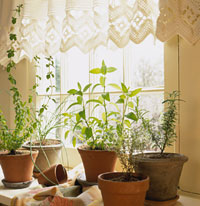
You will eat better and even save money by growing herbs indoors -- fresh ingredients for your cold-weather cooking cost next to nothing. An herb garden adds an attractive, economic aspect to the kitchen.
Place your herb containers by the sunniest window you can. Put the die-hard sun lovers in the center and the less demanding off to the sides. Of the five herbs we recommend for indoor culture, oregano requires the most light.
If you don't have an herb garden outdoors, you can start from scratch indoors, despite the fact that icy weather is starting to threaten.
Even in late fall, it's not too late to buy. In many areas of the country, prices are slashed on the last lonely herbs in garden centers. If your local nurseries are shuttered, you can make a quick call to mail-order nurseries and have them ship you a selection. Do make sure they are astute enough not to send your new garden out the door just as a sudden spell of particularly nasty weather strikes.
We suggest you go with these five herbs: oregano, chives, mint, rosemary, and thyme. Most cooks use them on a regular basis, and they will actually make it through the winter in your indoor garden. If you're lucky, you can even harden them off and plant them outdoors come spring.
A caution about selecting your herbs: Just because you like to cook with a particular ingredient doesn't mean you can grow that plant indoors. As much as you may love basil, for instance, this herb turns into a sorry specimen after a few weeks cooped up inside.

You will need to pot up some smallish-size herb plants, because the containers need to fit on a windowsill. 4-inch pots work nicely.
Remember to use pots with drainage holes so your herbs don't rot. And that means the pots need to rest in saucers, which -- if you are eyeing the width of your sill right now -- should be a little wider than the pots. So you need at least a 5-inch windowsill. We like terra-cotta pots, but they do dry out quickly in winter's heated indoor "weather," and the saucers leak. Use a plastic liner or rubber pad.
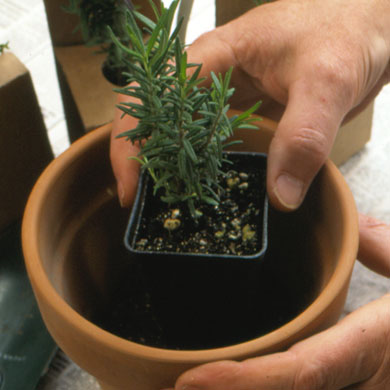 Step 1
Step 1
1. Cover the drainage hole with a small square of window screening; then fill the bottom one-third or so of the pot with potting soil. Use the plastic nursery container (with the plant still in it) to check the soil level.
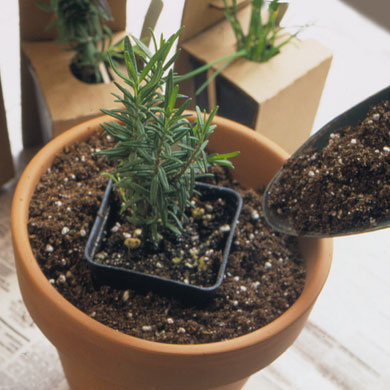 Step 2
Step 2
2. At this point, you can just pull the herb out of its original nursery container and place it on the soil. But here's a neat trick: Put the herb -- while it is still in its nursery container -- in your windowsill pot, and fill with potting soil. You read that right: You now have a pot within a pot. It gets less confusing.
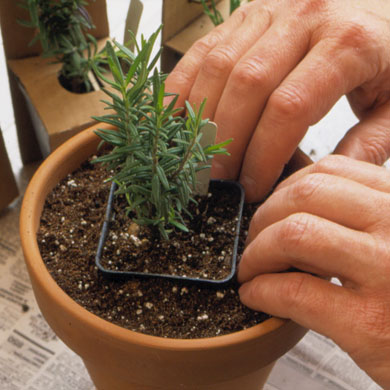 Step 3
Step 3
3. Press down the soil between the rims of the two pots with a thick dowel or your fingertips. Add more soil as needed. Do not press down the soil in the plastic nursery container. Still with us?
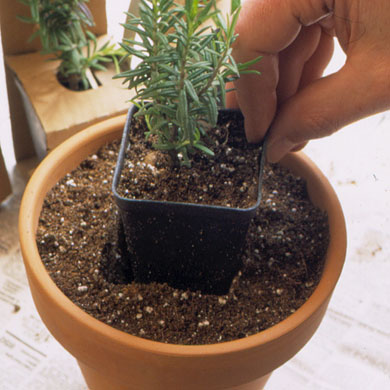 Step 4
Step 4
4. Now carefully remove the nursery container (and plant) from your windowsill pot. There will remain a perfectly formed hole in the center of the terra-cotta pot. You probably already know what's coming.
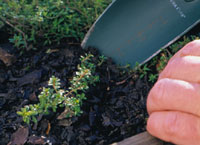 Step 5
Step 5
5. You take the herb out of the plastic nursery container and place it in the dark void at the center of your terra-cotta pot. It fits! Now water the soil and get growing.
Another way to start a winter herb garden indoors is to move plants from your garden into your kitchen.
You won't want to uproot whole plants, because by this time of year they are far too large for just about any windowsill. And buying pots for huge herbs would offset any savings you might make by growing gargantuan greens indoors. What you want to save are pieces of the plant runners or divisions. Herbs like chives and mint divide easily; others require a bit more work.
However, since the plants at this point are basically freebies, you don't need to concern yourself as much with what will make it through the dry-heat season indoors. If they die, they die, and you've had free fresh herbs out of season for however long it took those ill-fated herbs to sputter out.
Do not consider any such windowsill sputtering as a gardening failure. Consider it scientific experimentation and financial pioneering. Maybe you do want to try growing that basil indoors after all.
 Step 1
Step 1
1. To transfer suitably-sized outdoor herbs to your windowsill pot, look for new growth. Some herbs can be divided. Others, such as this golden thyme, can be separated from the mother plant by inserting a trowel sharply just behind the newly-formed roots of an advancing stem.
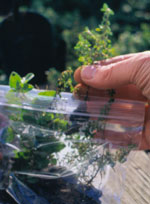 Step 2
Step 2
2. Put the plant and root ball in a plastic bag to transport it back to your kitchen sink or potting table.
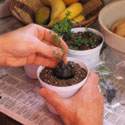 Step 3
Step 3
3. Pot it up, water thoroughly, and sharpen your scissors.
Copyright © www.100flowers.win Botanic Garden All Rights Reserved